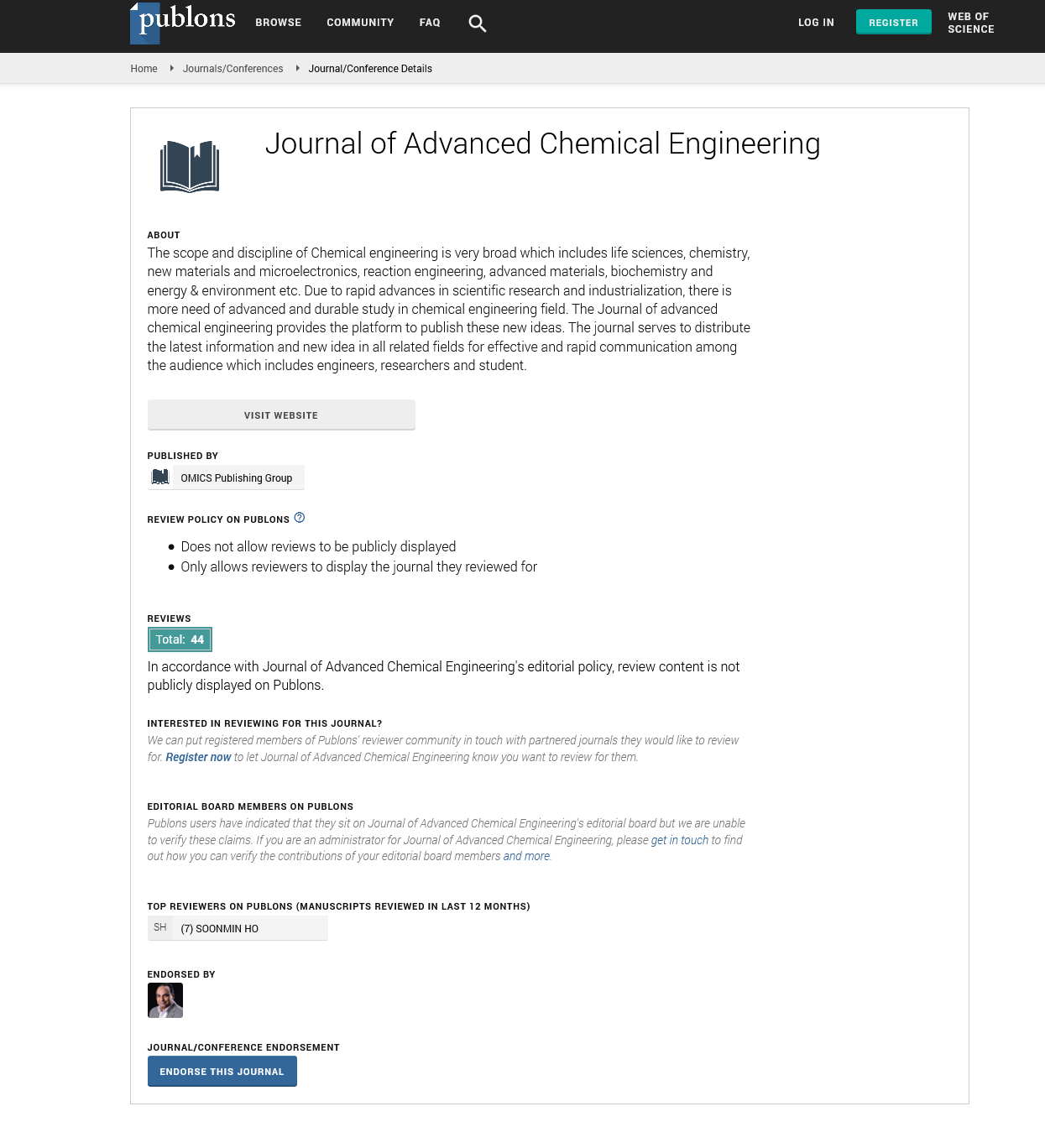Indexed In
- Open J Gate
- Genamics JournalSeek
- Smithers Rapra
- RefSeek
- Directory of Research Journal Indexing (DRJI)
- Hamdard University
- EBSCO A-Z
- OCLC- WorldCat
- Scholarsteer
- Publons
- Geneva Foundation for Medical Education and Research
- Google Scholar
Useful Links
Share This Page
Journal Flyer

Open Access Journals
- Agri and Aquaculture
- Biochemistry
- Bioinformatics & Systems Biology
- Business & Management
- Chemistry
- Clinical Sciences
- Engineering
- Food & Nutrition
- General Science
- Genetics & Molecular Biology
- Immunology & Microbiology
- Medical Sciences
- Neuroscience & Psychology
- Nursing & Health Care
- Pharmaceutical Sciences
Perspective - (2025) Volume 15, Issue 2
Smart Materials in Chemical Engineering: Transforming Industrial Applications
Marco DeLuca*Received: 30-May-2025, Manuscript No. ACE-25-29808; Editor assigned: 02-Jun-2025, Pre QC No. ACE-25-29808 (PQ); Reviewed: 16-Jun-2025, QC No. ACE-25-29808; Revised: 23-Jun-2025, Manuscript No. ACE-25-29808 (R); Published: 30-Jun-2025, DOI: 10.35248/2090-4568.25.15.369
Description
Smart materials represent one of the most fascinating and transformative innovations in chemical engineering, offering unprecedented opportunities for industries to develop adaptive, efficient, and sustainable processes. Unlike conventional materials, smart materials are designed to respond to external stimuli such as temperature, pressure, pH, light, or electrical fields in predictable and reversible ways. This adaptability opens entirely new avenues for applications across energy, healthcare, construction, electronics, and environmental management. For chemical engineers, the ability to manipulate material behavior at both micro and macro levels is reshaping the design of processes and products, setting the stage for a new industrial revolution grounded in responsiveness and sustainability.
The origins of smart material development can be traced back to early research into polymers and composites, but advances in nanotechnology, molecular engineering, and process intensification have allowed chemical engineers to push the boundaries of what materials can achieve. For instance, shape-memory alloys, which can return to their original form after deformation when exposed to a stimulus such as heat, have been incorporated into aerospace and medical devices. Similarly, piezoelectric materials, which generate electrical charge under mechanical stress, are used in sensors and actuators across a wide range of industries. These examples highlight how smart materials enable multi-functionality, integrating sensing, actuation, and self-healing capabilities into traditional materials.
In chemical engineering, smart polymers are particularly significant. These materials can undergo phase transitions in response to changes in temperature or pH, making them ideal for controlled release systems in drug delivery or stimuli-responsive coatings that adapt to their environment. Hydrogels that swell or shrink based on environmental cues are being developed for wastewater treatment, where they can selectively capture contaminants and then release them under specific conditions for regeneration. This adaptability reduces resource consumption and offers scalable solutions for industries seeking to minimize their environmental footprint.
Nanotechnology further amplifies the impact of smart materials by enabling precision control at the molecular level. Carbon nanotubes, graphene, and nanocomposites are being engineered with responsive properties that enhance strength, conductivity, and adaptability. For instance, self-healing nanocomposites can repair micro-cracks without external intervention, extending the lifespan of pipelines, reactors, and infrastructure. Such advances reduce maintenance costs, increase safety, and improve overall system reliability. Additionally, responsive nanomaterials are being used in catalytic systems where they dynamically adjust surface properties to optimize reaction efficiency, leading to reduced energy requirements and higher yields in industrial chemical processes.
Smart materials also intersect with the energy sector, where chemical engineers are driving the development of adaptive systems for storage and conversion. Phase-change materials, which absorb or release thermal energy during transitions between solid and liquid states, are being integrated into energy storage units for renewable power systems. These materials stabilize energy supply by capturing excess heat or electricity and releasing it during peak demand. In parallel, photoresponsive materials are being employed in solar energy harvesting to improve light absorption efficiency. The integration of such materials into industrial-scale systems aligns with the growing global demand for sustainable and resilient energy solutions.
Environmental applications of smart materials are equally transformative. Stimuli-responsive adsorbents are being designed for carbon capture, allowing materials to selectively bind COâ?? molecules under specific conditions and then release them for sequestration or utilization. These systems not only improve capture efficiency but also reduce the energy intensity of regeneration compared to conventional methods. Similarly, smart membranes with tunable pore sizes are revolutionizing water purification and desalination, enabling dynamic control over selectivity and flux. These advances promise to address pressing global challenges related to water scarcity, climate change, and pollution.
Citation: DeLuca M (2025). Bioprocess Intensification in Advanced Chemical Engineering: A Pathway to Industrial Efficiency. Adv Chem Eng. 15:369.
Copyright: ©2025 DeLuca M. This is an open-access article distributed under the terms of the Creative Commons Attribution License, which permits unrestricted use, distribution, and reproduction in any medium, provided the original author and source are credited.

